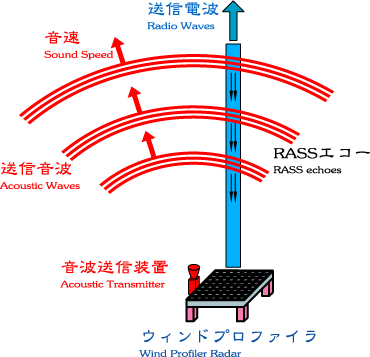
Principles of RASS (Radio Acoustic Sounding System)
The wind profiler uses a technology known as RASS (Radio Acoustic Sounding System) to measure virtual temperature profiles.
With this observation method, acoustic pulses are transmitted from a ground-based acoustic transmitter and radio waves are emitted from the wind profiler toward the acoustic wave fronts in the sky. Radio waves reflected by the acoustic wave fronts are then received, and the sound velocity is determined (based on the Doppler effect of the radio waves) to determine the virtual temperature.
 A remote sensor combining a wind profiler and an acoustic source A remote sensor combining a wind profiler and an acoustic source
 Sound velocity is measured to calculate virtual temperature. Sound velocity is measured to calculate virtual temperature.
 Equation Equation
- Tv = (Cs/20.047)22
- Tv: virtual temperature
- Cs: sound velocity
 The acoustic wave fronts and the antenna beams must be orthogonal to each other (the Bragg condition). The acoustic wave fronts and the antenna beams must be orthogonal to each other (the Bragg condition).
 To determine the true sound velocity, corrections must be made for radial wind velocity. To determine the true sound velocity, corrections must be made for radial wind velocity.
- Cs = Ca-Vr
- Ca: Radial velocity of sound
- Vr: Radial wind velocity

|